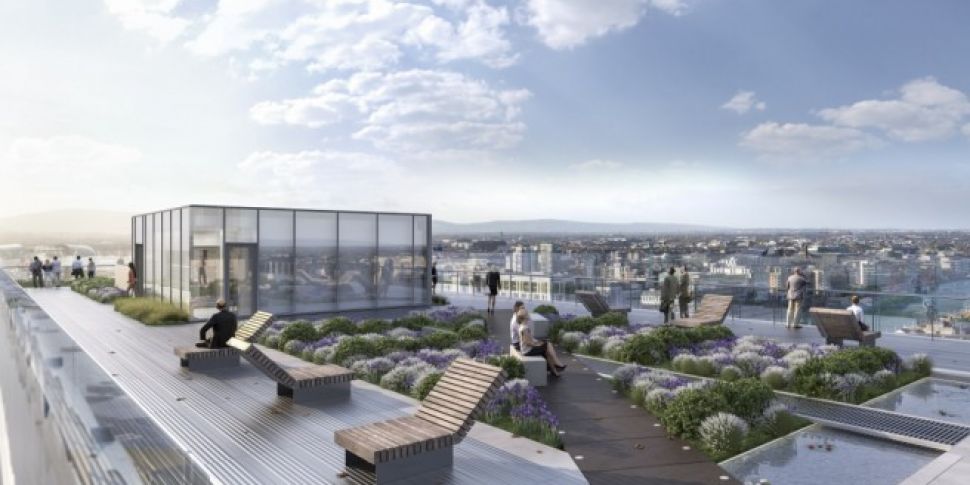The signs continue to emanate from the docklands, as is so often the case these days, that an economically rejuvenated Dublin is ready to properly grow up.
As calls come from politicians and business groups to open the capital up to vertical ways of thinking and address some of its key issues in the process, news of fresh additions to the skyline arrived this week.
First of all, to the sure thing. The decade got underway with Google laying claim to Dublin's tallest building, as the imposing, state-of-the-art 67m Montevetro building on Barrow Street became the property of the internet search giant.
If the pioneering US company wants to stay on top of the heap, however, it'll have to start thinking about adding a few floors.
There's a new landmark on the way and its just taken a significant step to becoming a reality.

A building contractor is now being sought for "The Exo", which will be Dublin's tallest commercial office building at 73 metres high when completed.
Joint receivers Stephen Tennant and Paul McCann of Grant Thornton announced on Thursday that a tender had been issued for the appointment of that contractor, while Savills and CBRE have also been instructed to seek pre-letting agreements with tenants.
The proposed Point Square building in Dublin's docklands should arrive in two years' time at a cost of €70m and will be capable of housing up to 2,000 workers.

Roland O'Connell of Savills sold the new tower thusly:
"The Exo will provide the most spectacular workspace in the city. Its accessibility is unrivalled with the Luas stopping outside and the Port Tunnel providing quick access to the M50 and a 15 minute trip to Dublin Airport – surely one of the quickest airport links in the world."

All well and good, but it may not be master of all it surveys for long if the oft-controversial Johnny Ronan gets his way.
Just pipping The Exo to the post on the headline-making front, the developer's – as yet speculative –skyscraping plans for the far side of the Liffey were also unveiled.

According to The Irish Times, Ronan is aiming to create Dublin's tallest building, complete with a top floor bar and restaurant with (for now) unbeatable panoramic views of the capital as its selling point.
The tower development would sit on a site adjoining Tara Street railway station and contain a 110-bedroom hotel, as well as a restaurant/cafe terrace on the ground floor.
At a height of 88 metres (close to 290ft), its 17 storeys would tower above both the historically imposing Liberty Hall (59m) and the aforementioned Monte Vetro.

In many other major cities, these announcements would be warmly welcomed by the majority of the public (if the heights didn't seem so relatively stunted next to their own record-breakers). Dublin is different though, a place where people take no small amount of pride in how its stayed true, through the Celtic Tiger years and all, to its low-rise roots.
So there is a lot of emphasis in the Tara House plans, for example, on ensuring everything is done in the best possible taste.
'A jewel in the skyline'
It has been designed by HJL Architects with the intention of making it a "landmark gateway" between Dublin's historic core and the contemporary architectural approach favoured in the Docklands.
An illustrious design review panel recommended that it should aim to “achieve a timeless design, rather than a flashy ‘icon’ to make this building so obviously different from anything else in the city that it has to be assessed as a special case, not just another commercial development."
The panel also said that the relative skyscraper “would need to be of the highest design quality, a jewel on the skyline... to deflect criticism of the effect of the tower on other city landmarks.”
Even with these public displays to appease the aesthetes out there, The Exo and Tara House remain exceptions that prove the rule, rare endeavours upwards in a city where regulations insist that most of the space remains as flat as possible.

When you start moving towards the suburbs, development are typically not permitted to be above four storeys.
Nobody wants innumerable towers springing up all over the place, but some are suggesting that a compromise could go a long way to solving some of the capacity problems we're having when it comes to housing and office space. Further restrictions – which have been floated – are surely not the way forward, they argue.
Employers' group Ibec is one vocal proponent of high-rise living.
Last August, it took umbrage with a proposed reduction in the maximum height allowed for low-rise residential buildings in the inner city and suburbs.
It declared proposals in a draft Development Plan for Dublin to be "crazy" given the pressure of population growth.
Ibec's Aidan Sweeney made the case that easing restrictions would attract investment:
"The new Dublin City Development Plan must recognise that we are in a time of acute housing shortages, we have a growing population.
"But also we are a global competitive city and we need to take advantage of opportunities that, for instance, Brexit and uncertainty in the UK have actually thrown up for other cities around Europe."

In the event, the new plan was adopted by city councillors in September and provided for higher residential buildings in the city – two additional floors in the inner city and transportation hubs (maximum height 24m) and one additional floor in suburbs (maximum height 13m).
Dr Lorcan Sirr, DIT’s resident housing expert, told Newstalk that those allowances are quite enough for Dublin.
“I would suggest that getting higher densities might be a more appropriate solution for the Irish landscape," he countered. "High-rise also becomes expensive after about 10-12 stories, so some cost efficiencies are absorbed by this additional expense. Higher densities through a better use of existing space – getting rid of front gardens, for example – might work better.”
The political pressure to deal with the housing squeeze is only increasing.

Speaking to Newstalk Drive in February, Housing Minister Simon Coveney stated that Dublin will need “at least” an additional 500,000 houses by 2040.
“We need to first of all end this perception that height somehow compromises the quality of life in our cities,” he said.
“If you look at how modern cities – like Copenhagen for example – have developed, yes you go higher but you have higher quality buildings and you have open space at the base of them to ensure that you have good high quality common space areas.
“That is the kind of development we need in Dublin if people are going to be able to live near where they are working.”
The view from the top of the country's governing power. Time will tell if it's an attitude that is trickling down with increasing frequency.









